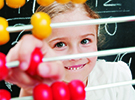What Comes in Twos, Threes and Fours?
In this lesson, children will be able to recognize, sort and differentiate objects in groups of two, three and four.
Lesson for:
Toddlers/Preschoolers
(See Step 5: Adapt lesson for toddlers or preschoolers.)
Content Area:
Algebra
Learning Goals:
This lesson will help toddlers and preschoolers meet the following educational standards:
- Understand numbers, ways of representing numbers, relationships among numbers and number systems
- Understand meanings of operations and how they relate to one another
- Understand patterns, relations and functions
Learning Targets:
After this lesson, toddlers and preschoolers should be more proficient at:
- Counting with understanding and recognizing “how many” in sets of objects
- Understanding situations that entail multiplication and division, such as equal groupings of objects and sharing equally
- Sorting, classifying and ordering objects by size, number and other properties

What Comes in Twos, Threes and Fours?
Lesson plan for toddlers/preschoolers
Step 1: Gather materials.
- The book, What Comes in 2’s, 3’s and 4’s by Suzanne Aker
- Chart paper divided into three categories (Sets of two, sets of three and sets of four)
- Blank pieces of paper, plus markers, crayons and pencils, so that the children can make their own books
Note: Small parts pose a choking hazard and are not appropriate for children age five or under. Be sure to choose lesson materials that meet safety requirements.
Step 2: Introduce activity.
- Read the book, What Comes in 2’s, 3’s and 4’s. As the book is being read, pause to brainstorm things that come in twos, three and fours. Write down the things that the book mentions and ideas that the children come up with on the chart.
Step 3: Engage children in lesson activities.
- After reading the story, have the children sort the bears into groups of two, three and four.
- Children will make their own books, drawing objects that come in twos, threes and fours. They can use the objects that have been previously noted on the chart or come up with new ideas.
Additional Extensions
- Send the children on a scavenger hunt to collect items that come in “groups of.” The number can exceed four, as they might find an egg carton and decide to start a category of “objects that come in twelves.” Once the children have collected their items, construct a bar graph that shows the numbers that were being scavenged. One space should be colored in for each item found that represents that number. Use the graph to teach one or more of the following concepts: more than, less than, equal, same as, addition and subtraction. This can be accomplished by having the children look at the graph to answer specific questions such as: “Which number has the most? The least? How many would we have to add to the twos column to make it equal to the threes column?”
Step 4: Vocabulary.
- Groups: Equal sets (e.g.,”How many groups of bears do you have?”)
- Sort: Separating the items according to a given attribute (e.g.,”Let’s sort the bears into equal groups of three.”)
- Equal: To be the same in number or amount (e.g.,”Sort the bears into equal groups of three.”)
Step 5: Adapt lesson for toddlers or preschoolers.
Adapt Lesson for Toddlers
Toddlers may:
- Be having difficulty concentrating on more than one number to group
Child care providers may:
- Concentrate on just one grouping, such as things that come in twos
- Put together a series of objects or pictures of objects and have the children sort the pictures into groups of two, three and four
Adapt Lesson for Preschoolers
Preschoolers may:
- Easily think of grouped objects and easily sort the bears into equal groups
Child care providers may:
- Send the children on a scavenger hunt to collect items that come in “groups of.” The number can exceed four, as they might find an egg carton and decide to start a category of “objects that come in twelves.”
- Once they have collected their items, construct a bar graph that shows the numbers that were being scavenged. One space should be colored in for each item found that represents that number. Use the graph to teach one or more of the following concepts: more than, less than, equal, same as, addition and subtraction. This can be accomplished by having the children look at the graph to answer specific questions such as: “Which number has the most? The least? How many would we have to add to the twos column to make it equal to the threes column?”
Suggested Books
- What Comes in 2’s, 3’s or 4’s by Suzanne Aker (New York: Aladdin, 1992)
Music and Movement
Outdoor Connections
Give the children a clipboard with a piece of paper divided into three categories: sets of two, sets of three and sets of four. Have the children walk around and write down or draw objects that they see that come in sets of two, three or four. You might need to lead them to particular objects or have them study everyday objects more closely.
Comment on this lesson